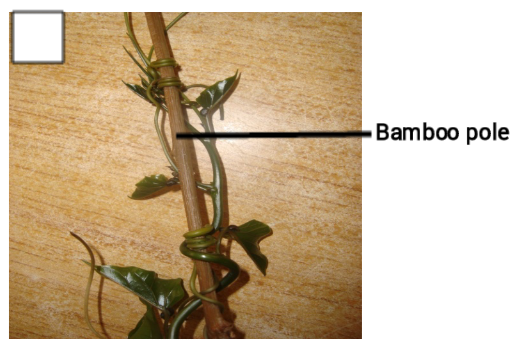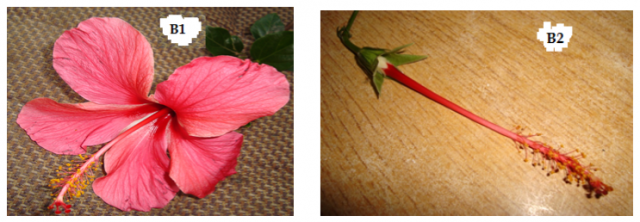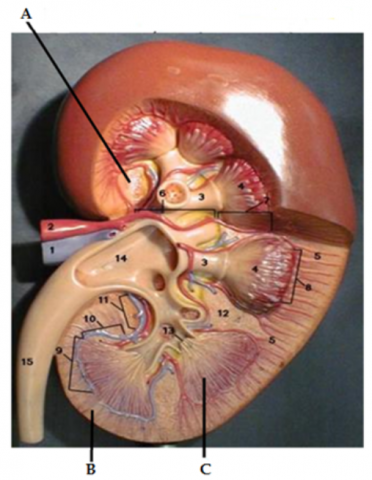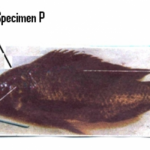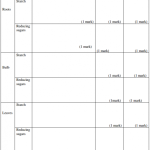KNEC KCSE Biology Paper 3 Question Paper / 2015 KCSE Starehe Boys Centre Mock
2015 KCSE Starehe Boys Centre Mock
Biology Paper 3
(a)You are provided with two pieces of specimen K which is a plant structure, a scalpel blade and
two solutions labeled L1 and L2.With one of the pieces of specimen K held vertically, place the
blade edge at the top centre of the specimen as illustrated below
Smoothly cut the piece longitudinally through the centre in the direction of the arrows as illustrated above up to approximately half the length of the plant structure. Place this partially cut piece in solution L1. Repeat the procedure with the second piece of specimen K and place this second piece in solution L2. Allow the set ups to stand for 45 minutes and then remove the pieces of specimen K and wipe off excess solution using tissue paper.
Observe and draw illustrations showing the results of the two experimental set ups
(2 marks)
Piece from solution L1
Piece from solution L2
In one word in each case, describe the texture of each of the pieces of specimen K
(2 marks)
Piece from solutionL1
……………………………………………………………………………………………………………
Piece from solution L2
……………………………………………………………………………………………………………
Account for the results of the set up in solutionL2 (3 marks)
……………………………………………………………………………………………………………
……………………………………………………………………………………………………………
……………………………………………………………………………………………………………
……………………………………………………………………………………………………………
……………………………………………………………………………………………………………
……………………………………………………………………………………………………………
You are provided with a solution labeled N which is a food sample, solution H- Benedict’s solution, solution G-Iodine solution, and solution F whose identity is unspecified
(i) Conduct food tests using the reagents provided and complete the table below (4 marks)
Place 2cm3 of solution N in a test tube. Add 1cm3 of solution F. Place the mixture in a
water bath maintained at 400C for 30 minutes and repeat Benedict’s test on the resultant mixture. State your observations and conclusions (2 marks)
Observations
……………………………………………………………………………………………………………
……………………………………………………………………………………………………………
Conclusion
……………………………………………………………………………………………………………
……………………………………………………………………………………………………………
Give the identity of solution F (1 mark)
……………………………………………………………………………………………………………
Account for the results in (b)(ii) above (2 marks)
……………………………………………………………………………………………………………
……………………………………………………………………………………………………………
……………………………………………………………………………………………………………
16 marks
a) Study photograph A below which shows a plant specimen and an associated sisal pole and
answer the questions that follow.
(i) What name is given to the coiled part of the plant specimen shown in photographA?
(1 mark)
……………………………………………………………………………………………………………
(ii) Name the type of response exhibited by the coiled part of the plant specimen in photograph A (1 mark)
……………………………………………………………………………………………………………
(iii) Specify the stimulus responsible for the response named in (a)(ii) above (1 mark)
……………………………………………………………………………………………………………
(iv) Explain how the response exhibited by the coiled part of the plant specimen in photograph A occurred (3 marks)
……………………………………………………………………………………………………………
……………………………………………………………………………………………………………
……………………………………………………………………………………………………………
……………………………………………………………………………………………………………
……………………………………………………………………………………………………………
(iv) State the biological significance of the response described in (iv) above to the survival of the plant (1 mark)
……………………………………………………………………………………………………………
……………………………………………………………………………………………………………
(b)
Study photographs B1 and B2 below carefully and answer the questions that follow. The part in B2 was extracted from the specimen inB1
(i)Identify the agent of pollination of the specimen shown in the photographs above
(1mark)
……………………………………………………………………………………………………………
(ii)Give a reason for your answer in (b)(i) above (1mark)
……………………………………………………………………………………………………………
(iii)Describe the pistil of specimen B1 (2 marks)
……………………………………………………………………………………………………………
……………………………………………………………………………………………………………
(iv)What is the name given to the type of pistil found in specimen B1? (1 mark)
……………………………………………………………………………………………………………
(v)Describe the external features of the leaves of the plant from which specimen B1 was obtained (3marks)
……………………………………………………………………………………………………………
……………………………………………………………………………………………………………
……………………………………………………………………………………………………………
15 marks
Below is a section through a mammalian organ
(a) On the photograph, name the parts labelled A, B and C (3marks)
(b) State two functions of the organ whose photograph is shown above (2marks)
………………………………………………………………………………..………………………………
………………………………………………………………………………..………………………………
(c) Label on the photograph using letters G and L the region where the glomerulus and the loop of Henle are located respectively (2marks)
(d) Name a process that occurs in the glomerulus and loop of Henle (2marks)
Glomerulus
………………………………………………………………………………..………………………………
Loop of Henle
………………………………………………………………………………..………………………………
9 marks


